
Lorado Zadok Taft was an American sculptor, writer and educator. His 1903 book, The History of American Sculpture, was the first survey of the subject and stood for decades as the standard reference. He has been credited with helping to advance the status of women as sculptors.

Charles Henry Niehaus was an American sculptor.

Garfield Park is a 128-acre (52 ha) regional city park in Indianapolis, Indiana, United States. Established in the late 19th century, it is the oldest city park in Indianapolis and is on the National Register of Historic Places. The park is located at the confluence of Pleasant Run and Bean Creeks on the near Southside of Indianapolis. The 10,000-square-foot (930 m2) Conservatory and Sunken Gardens are located in the eastern portion of the park. The noted landscape architect George Edward Kessler designed the Sunken Gardens along with many of the other features of the park as part of his Park and Boulevard Plan for the city.

The Indiana State Soldiers and Sailors Monument is a 284 ft 6 in (86.72 m) tall neoclassical monument built on Monument Circle, a circular, brick-paved street that intersects Meridian and Market streets in the center of downtown Indianapolis, Indiana. In the years since its public dedication on May 15, 1902, the monument has become an iconic symbol of Indianapolis, the state capital of Indiana. It was added to the National Register of Historic Places on February 13, 1973 and was included in an expansion of the Indiana World War Memorial Plaza National Historic Landmark District in December 2016. It is located in the Washington Street-Monument Circle Historic District. It is also the largest outdoor memorial and the largest of its kind in Indiana.
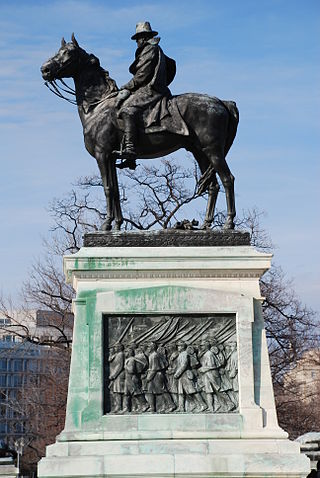
The Ulysses S. Grant Memorial is a presidential memorial in Washington, D.C., honoring American Civil War general and 18th United States President Ulysses S. Grant. It sits at the base of Capitol Hill, below the west front of the United States Capitol. Its central sculpture of Grant on horseback faces west, overlooking the Capitol Reflecting Pool and facing toward the Lincoln Memorial, which honors Grant's wartime president, Abraham Lincoln. Grant's statue is raised on a pedestal decorated with bronze reliefs of the infantry; flanking pedestals hold statues of protective lions and bronze representations of the Union cavalry and artillery. The whole is connected with marble covered platforms, balustrades, and stairs. The Grant and Lincoln memorials define the eastern and western ends, respectively, of the National Mall.
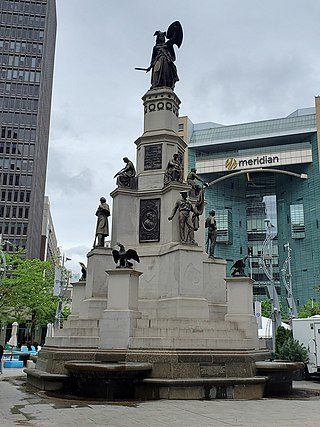
The Michigan Soldiers' and Sailors' Monument is a Civil War monument located in Downtown Detroit, Michigan. This example of civic sculpture stands in a prominent location on the southeast tip of Campus Martius Park, where five principal thoroughfares—Michigan Avenue, Monroe Street, Cadillac Square, Fort Street, and Woodward Avenue—convene on the reconstructed traffic circle in front of One Campus Martius Building. It was listed on the National Register of Historic Places in 1984.
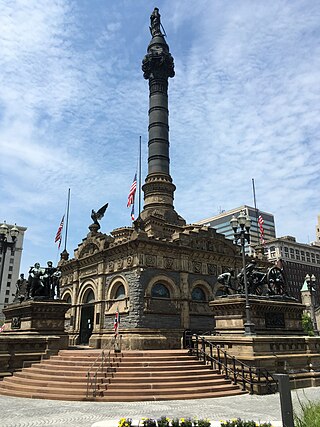
The Cuyahoga County Soldiers' and Sailors' Monument is a major Civil War monument in Cleveland, Ohio, honoring the more than 9,000 individuals from Cuyahoga County who served the Union throughout the war. It was dedicated on July 4, 1894, and is located on the southeast quadrant of Public Square in Downtown Cleveland. It was designed by architect and Civil War veteran Levi Scofield, who also created the monument's sculptures. The monument is regularly open to the public, free of charge.
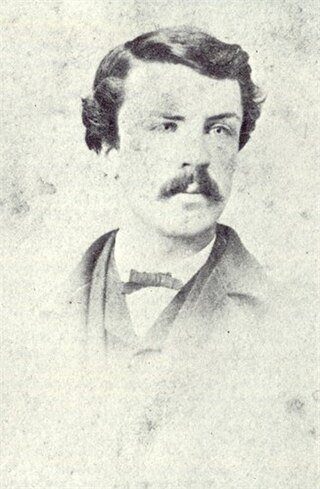
George Keller was an American architect and engineer. He enjoyed a diverse and successful career, and was sought for his designs of bridges, houses, monuments, and various commercial and public buildings. Keller's most famous projects, however, are the Soldiers and Sailors Memorial Arch in Hartford, Connecticut, and the James A. Garfield Memorial in Cleveland, Ohio.
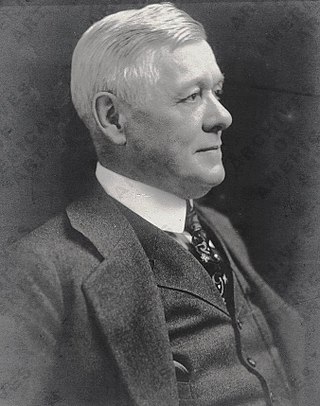
John Massey Rhind was a Scottish-American sculptor. Among Rhind's better known works is the marble statue of Dr. Crawford W. Long located in the National Statuary Hall Collection in Washington D.C. (1926).
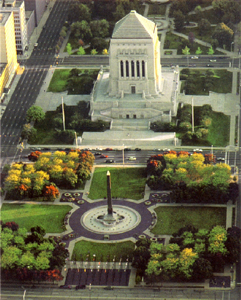
The Indiana World War Memorial Plaza is an urban feature and war memorial located in downtown Indianapolis, Indiana, United States, originally built to honor the veterans of World War I. It was conceived in 1919 as a location for the national headquarters of the American Legion and a memorial to the state's and nation's veterans.

The Confederate Monument in Glasgow, Kentucky, built in 1905 by the Kentucky Women's Monumental Association and former Confederate soldier John A. Murray, commemorates those who gave their lives in service for the Confederate States of America. It is located on the side of Glasgow's courthouse. The Confederate soldier, made of bronze, is at parade rest, and features details such as a bedroll, canteen, kepi hat, and rifle. It stands on a limestone pedestal.

The Soldiers and Sailors Monument is a 43-foot (13 m) tall Gothic Revival memorial which stands in Penn Square in downtown Lancaster, Pennsylvania. It was dedicated on July 4, 1874, at its present site on the Northeast intersection of King and Queen Streets. The monument's original intention was to pay tribute to Lancastrian Union soldiers killed during the American Civil War. However, today the Soldiers and Sailors Monument also represents those who have served in subsequent American military conflicts.

Admiral David G. Farragut is a statue in Washington, D.C., honoring David Farragut, a career military officer who served as the first admiral in the United States Navy. The monument is sited in the center of Farragut Square, a city square in downtown Washington, D.C. The statue was sculpted by female artist Vinnie Ream, whose best-known works include a statue of Abraham Lincoln and several statues in the National Statuary Hall Collection. The monument was dedicated in 1881 in an extravagant ceremony attended by President James A. Garfield, members of his cabinet, and thousands of spectators. It was the first monument erected in Washington, D.C., in honor of a naval war hero.
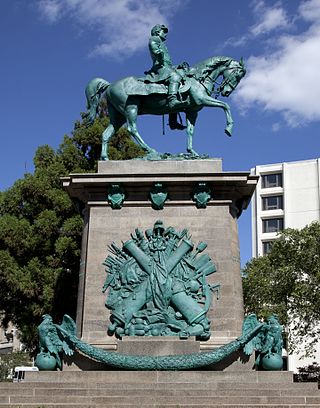
Major General George B. McClellan is an equestrian statue in Washington, D.C. that honors politician and Civil War general George B. McClellan. The monument is sited on a prominent location in the Kalorama Triangle neighborhood due to efforts made by area residents. The statue was sculpted by American artist Frederick William MacMonnies, a graduate of the École des Beaux-Arts whose best known work is a statue of Nathan Hale in New York City. MacMonnies was chosen to design the statue following a lengthy competition organized by a statue commission, led by then Secretary of War William Howard Taft. The monument was dedicated in 1907, with prominent attendees at the ceremony including President Theodore Roosevelt, New York City mayor George B. McClellan Jr., politicians, generals and thousands of military personnel.

The Dupont Circle Fountain, formally known as the Rear Admiral Samuel Francis Dupont Memorial Fountain, is a fountain located in the center of Dupont Circle in Washington, D.C. It honors Rear Admiral Samuel Francis Du Pont, a prominent American naval officer and member of the Du Pont family. The fountain replaced a statue of Du Pont that was installed in 1884. Designed by Henry Bacon and sculpted by Daniel Chester French, the fountain was dedicated in 1921. Prominent guests at the dedication ceremony included First Lady Florence Harding, Secretary of War John W. Weeks and Secretary of the Navy Edwin Denby.

The statue of John Aaron Rawlins, a United States Army general who served during the Civil War and later as Secretary of War, is a focal point of Rawlins Park, a small public park in Washington, D.C.'s Foggy Bottom neighborhood. It was installed in 1874, but relocated several times between 1880 and 1931. The statue was sculpted by French-American artist Joseph A. Bailly, whose best known work is the statue of George Washington in front of Independence Hall in Philadelphia.

The Stephenson Grand Army of the Republic Memorial, also known as Dr. Benjamin F. Stephenson, is a public artwork in Washington, D.C. honoring Dr. Benjamin F. Stephenson, founder of the Grand Army of the Republic, a fraternal organization for Union veterans. The memorial is sited at Indiana Plaza, located at the intersection of 7th Street, Indiana Avenue, and Pennsylvania Avenue NW in the Penn Quarter neighborhood. The bronze figures were sculpted by J. Massey Rhind, a prominent 20th-century artist. Attendees at the 1909 dedication ceremony included President William Howard Taft, Senator William Warner, and hundreds of Union veterans.

The Black Hawk County Soldiers Memorial Hall, also known as Veterans Memorial Hall, is a Classical Revival veterans hall located at 1915 Courbat Ct. in downtown Waterloo, Black Hawk County, Iowa. It was built starting in June 1915 and first meeting was held there in December of the same year by the Grand Army of the Republic as a memorial to soldiers who died in the American Civil War. It was listed on the National Register of Historic Places in 1988 due to its architecture and importance in local history.





















